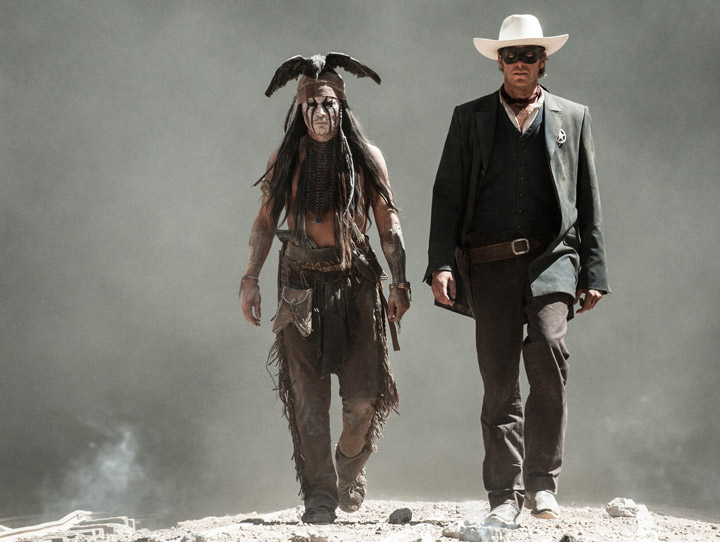TORONTO — If you think of “March of the Swiss Soldiers” from the William Tell Overture as nothing more than a piece of music by Italian composer Gioachino Rossini, then you’re probably not a fan of The Lone Ranger.

Whether you’re familiar with the classic American tale or not, Disney is hoping you will gallop to theatres this week to catch its much-hyped $250 million reboot, The Lone Ranger.
The movie, starring Armie Hammer as the masked hero and Johnny Depp as his sidekick Tonto, opens 80 years after the character first appeared on radio. (Canadian actor Barry Pepper, a native of Campbell River, B.C., also has a role.)
While The Lone Ranger spawned several TV shows and movies, more than a dozen novels, two comic strips, hundreds of comic books and even a 1991 video game, it hasn’t been a huge hit in at least four decades.
CBS rejected a 1961 pilot The Return of the Lone Ranger and a 1981 movie The Legend of the Lone Ranger — starring Klinton Spilsbury and Michael Horse — flopped at the box office.
For the uninitiated, the Lone Ranger is John Reid, the sole survivor of an ambush of Texas Rangers by Butch Cavendish and his outlaws, who is rescued by an Indian named Tonto. To conceal Reid’s identity, Tonto makes a black mask from the vest of one of the dead Rangers — Reid’s older brother Capt. Daniel Reid — and the two dedicate their lives to fighting crime.

Get daily National news
The Lone Ranger brought silver bullets, “kemosabe” and, yes, the William Tell Overture into American pop culture.
Here are 10 more things to know about The Lone Ranger:
1. A hero of the southwest, the Lone Ranger’s roots are actually across the lake from Toronto. Although The Lone Ranger premiered in January 1933 on Detroit radio station WXYZ — the character first appeared in test episodes on WEBR in Buffalo, New York. More than 2,500 episodes of the radio series were broadcast up until 1956.
2. The Lone Ranger was created by lawyer and producer George Trendle and writer Francis Striker. The latter died in a car accident in 1962 at the age of 59, southeast of Buffalo.
3. The Lone Ranger was portrayed on radio by John Barrett, George Seaton, James Jewell, Earle Graser, Fred Foy and Brace Beemer. The Lone Ranger’s sidekick Tonto, who didn’t appear until the 11th episode of the series, was portrayed by John Todd and Roland Parker. James Lipton, who went on to host Inside the Actors Studio, was among the child actors who voiced the Lone Ranger’s nephew Dan Reid.
4. The Lone Ranger became an ABC TV series in 1949. Filmed in California and Utah, it was the first Western made for television. A whopping 221 episodes were produced and aired over five seasons — in black and white up until 1956. The series earned two Emmy nominations but never won.
5. On television, the Lone Ranger was played by Clayton Moore. He briefly left the show, reportedly over creative differences, and was replaced for 52 episodes by John Hart. Moore is the only person to have a star on the Hollywood Walk of Fame with both his name and his character’s name.
6. Jay Silverheels, who played The Lone Ranger’s sidekick Tonto in the TV series and movies, was born to a Mohawk chief on the Six Nations Reservation in Brantford, Ontario and was a star lacrosse player before moving to Hollywood to work as a stuntman. He was honoured with a star on the Hollywood Walk of Fame in 1979.
7. John Bennett Perry, the father of Ottawa-raised Friends star Matthew Perry, played Capt. Dan Reid in 1981’s The Legend of the Lone Ranger.
8. The Lone Ranger’s last name has always been Reid but his first name, John, wasn’t specified until 1953. His full name appears in The Legend of the Lone Ranger and the 2006 comic book series. In a 2003 TV movie, Chad Michael Murray starred as Luke Hartman, a Boston law student who becomes The Lone Ranger.
9. The Lone Ranger is the great-uncle of the Green Hornet. No, really. The creators of The Lone Ranger also came up with The Green Hornet. The Lone Ranger’s nephew is named Dan Reid, who is the father of The Green Hornet’s alter-ego Britt Reid.
10. Tonto’s term of endearment, “kemosabe,” was originally written as “ke-mo sah-bee” and said to be a Potawatomi phrase for a trusted scout or faithful friend. Jim Jewell, who directed the radio series, said the phrase was taken from Kamp Kee-Mo Sah-Bee, a boys’ camp on Mullett Lake in Michigan.










Comments